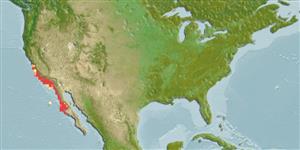Environment: milieu / climate zone / depth range / distribution range
Ecology
Marine; demersal; depth range 58 - 402 m (Ref. 2850). Subtropical; 8°C - 12°C (Ref. 131085); 38°N - 26°N, 125°W - 113°W
Eastern Central Pacific: Point Pinos, Monterey County in central California, USA to central Baja California, Mexico.
Size / Weight / Age
Maturity: Lm ? range ? - ? cm
Max length : 25.0 cm TL male/unsexed; (Ref. 2850); max. reported age: 15 years (Ref. 56049)
Common offshore water on flat bottom (Ref. 2850). Adults feed on krill and other zooplankton (Ref. 131085). Viviparous (Ref. 34817).
Life cycle and mating behavior
Maturity | Reproduction | Spawning | Eggs | Fecundity | Larvae
Eschmeyer, W.N., E.S. Herald and H. Hammann, 1983. A field guide to Pacific coast fishes of North America. Boston (MA, USA): Houghton Mifflin Company. xii+336 p. (Ref. 2850)
IUCN Red List Status (Ref. 130435: Version 2024-1)
Threat to humans
Harmless
Human uses
Fisheries: commercial; aquarium: public aquariums
Tools
Special reports
Download XML
Internet sources
Estimates based on models
Preferred temperature (Ref.
123201): 8.4 - 11.2, mean 9.2 °C (based on 9 cells).
Phylogenetic diversity index (Ref.
82804): PD
50 = 0.5000 [Uniqueness, from 0.5 = low to 2.0 = high].
Bayesian length-weight: a=0.00676 (0.00401 - 0.01141), b=2.99 (2.85 - 3.13), in cm total length, based on LWR estimates for this species & Genus-body shape (Ref.
93245).
Trophic level (Ref.
69278): 3.6 ±0.5 se; based on size and trophs of closest relatives
Generation time: 3.0 ( na - na) years. Estimated as median ln(3)/K based on 2
growth studies.
Resilience (Ref.
120179): Low, minimum population doubling time 4.5 - 14 years (tm=5; tmax=15; Fec=4,000).
Fishing Vulnerability (Ref.
59153): Low to moderate vulnerability (31 of 100).
